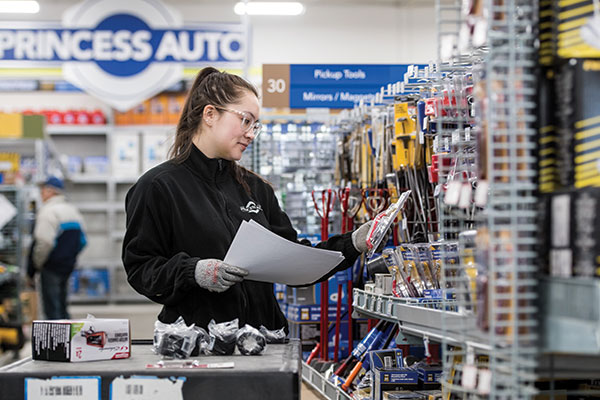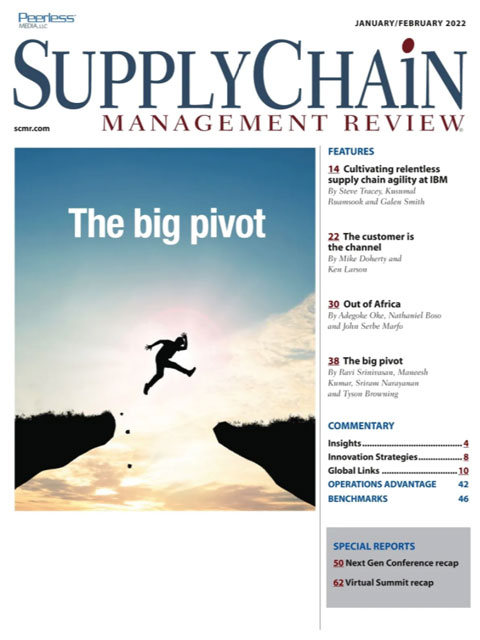Sorry, but your login has failed. Please recheck your login information and resubmit. If your subscription has expired, renew here.
January-February 2022
Well, that’s over, and aren’t we all glad to put 2020 in the rear-view mirror? For a minute, however, let’s look at a silver lining, because I think there is one for supply chain managers. That’s because the pandemic put supply chain in the spotlight like never before—and, with the approval of a vaccine just a few weeks ago in December, supply chain and cold chain are back in the news… While sales usually gets all the attention, maybe 2021 is our time to shine.” That’s the beginning of the column I wrote for the January 2021 issue, and maybe I was a little too pollyannish. Browse this issue archive.Need Help? Contact customer service 847-559-7581 More options
For most retailers, the last five years has been a relentless rise in digital commerce and heightened customer expectations. Needless to say, those trends, along with a demand for even more convenience and speed of delivery, were accelerated by the pandemic, as consumers shifted more of their purchases from brick-and-mortar and other traditional sales channels to the Web.
By all accounts, there is no end in sight. Some prognosticators on retail’s future are predicting as much as a 50/50 split between online and offline channels at some point in the future. While these kinds of predictions make for an entertaining academic exercise, the reality of the situation is simple—the customer doesn’t care. Steve Dennis summed it up perfectly in his book “Remarkable Retail:” “The customer is the channel.” And what do customers want? Among other things, they want a simple, harmonized path to purchase that makes them feel special, appreciated and valued. And, above all else, they expect product availability—when, where and how they wish to acquire it.
Key to meeting customer expectations is keeping inventory on the shelf—whether that shelf is in a store or a distribution center. Like most retailers, that has been both a challenge and a goal for Princess Auto Ltd (PAL), a national, Canadian, hard goods retailer with 51 stores located from coast-to coast. In 2015, before the pandemic, PAL realized it needed to improve its supply chain performance, and, as a result, embarked on an ambitious plan to improve planning capabilities, agility, inventory flow and—ultimately—its in-stock performance.
This article outlines how Princess Auto Ltd evolved its planning processes to a customer-driven, integrated supply chain, where stores are the key to satisfying customer demand, regardless of the channel. More importantly, it will share how the retailer used the flowcasting model and leveraged the agility and flexibility to pivot their customer fulfillment planning model—in the process improving product availability, customer order cycle times and margins.

This complete article is available to subscribers only.
Log in now for full access or start your PLUS+ subscription for instant access.
SC
MR
Sorry, but your login has failed. Please recheck your login information and resubmit. If your subscription has expired, renew here.
January-February 2022
Well, that’s over, and aren’t we all glad to put 2020 in the rear-view mirror? For a minute, however, let’s look at a silver lining, because I think there is one for supply chain managers. That’s because the… Browse this issue archive. Access your online digital edition. Download a PDF file of the January-February 2022 issue.For most retailers, the last five years has been a relentless rise in digital commerce and heightened customer expectations. Needless to say, those trends, along with a demand for even more convenience and speed of delivery, were accelerated by the pandemic, as consumers shifted more of their purchases from brick-and-mortar and other traditional sales channels to the Web.
By all accounts, there is no end in sight. Some prognosticators on retail’s future are predicting as much as a 50/50 split between online and offline channels at some point in the future. While these kinds of predictions make for an entertaining academic exercise, the reality of the situation is simple—the customer doesn’t care. Steve Dennis summed it up perfectly in his book “Remarkable Retail:” “The customer is the channel.” And what do customers want? Among other things, they want a simple, harmonized path to purchase that makes them feel special, appreciated and valued. And, above all else, they expect product availability—when, where and how they wish to acquire it.
Key to meeting customer expectations is keeping inventory on the shelf—whether that shelf is in a store or a distribution center. Like most retailers, that has been both a challenge and a goal for Princess Auto Ltd (PAL), a national, Canadian, hard goods retailer with 51 stores located from coast-to coast. In 2015, before the pandemic, PAL realized it needed to improve its supply chain performance, and, as a result, embarked on an ambitious plan to improve planning capabilities, agility, inventory flow and—ultimately—its in-stock performance.
This article outlines how Princess Auto Ltd evolved its planning processes to a customer-driven, integrated supply chain, where stores are the key to satisfying customer demand, regardless of the channel. More importantly, it will share how the retailer used the flowcasting model and leveraged the agility and flexibility to pivot their customer fulfillment planning model—in the process improving product availability, customer order cycle times and margins.
SC
MR


Latest Supply Chain News
- Retail sales see gains in October, reports Commerce and NRF
- Balancing green and speed: Home delivery insights from the pandemic era
- AdventHealth named top healthcare supply chain by Gartner
- Geopolitical readiness in supply chains: Strategic challenges for leaders
- Unlocking retention: The role employee engagement plays
- More News
Latest Podcast

 Explore
Explore
Software & Technology News
- Nine questions are the key to AI success in building resilient supply chains
- Looking back at NextGen 2024
- AI is moving omnichannel closer to the customer
- How technological innovation is paving the way for a carbon-free future in logistics and supply chains
- Körber Supply Chain Software’s Craig Moore says MercuryGate acquisition is about the customer
- Robotic use grows by 10%
- More Software & Technology
Latest Software & Technology Resources

Subscribe

Supply Chain Management Review delivers the best industry content.

Editors’ Picks





